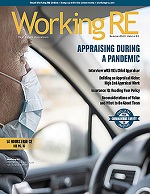 |
“One of the best courses that I have had in 17 years!” -Amy H
>> OREP E&O |
OREP/WRE Coronavirus Appraiser Blog
Coronavirus Appraiser Survey
>> New Survey: Appraiser Coronavirus Survey Part 2: What’s Changed?
Have You Reviewed these Sales? (Part 2)
Handling ROVs and Alternative Sales Requests
By Danielle Lopez
I wrote an article earlier this year titled Reconsideration of Value and What to Do About Them that generated a great deal of response. Shortly after publication, Working RE (WRE) began receiving numerous emails and calls from appraisers nationwide with questions, including where specifically they could find certain verbiage that was cited in the article.
Why is this such a hot button issue for appraisers? Precisely because these types of requests are becoming more and more commonplace in the industry, especially in the current market environment. With inventory currently low in most market areas, amidst an elevated level of demand, appraisers are increasingly facing a barrage of additional sales and reconsideration of value (ROV) requests from AMCs and underwriters. This not only saps the appraiser’s time by having to repeatedly explain and address a laundry list of inapplicable comparable sales, but it also places undue pressure on the appraiser. So let’s take a closer look at what rules are in place to protect appraisers and clarify the first story.
One of the points of confusion regarding the first article is the conflation of VA with Fannie Mae’s guidelines. Let’s clear that up first.
The Department of Veteran Affairs (VA) has guidelines for reconsideration of value that many of us appraisers consider the Gold standard. The VA requires that any lender or AMC submitting an ROV to an appraiser must:
1. Include no more than three sales.
2. Put the alternative sales on a grid and include supported documentation / verification such as MLS sheets, maps and tax records.
3. Provide a concise narrative explaining why the requester believes the comparables provided in the grid are superior to those selected by the appraiser.
So while the VA has clear guidelines on how to structure these requests when an underwriter, lender, or AMC staff decides to send over a list of comparables to be reviewed by the appraiser, Fannie Mae and the rest of the lending industry are doing things differently.
What Fannie Mae Says
While not as detailed as the VA, Fannie Mae does have guidelines on how lenders and AMCs should interact with appraisers when sending additional comparables to analyze, specifically if those comparables are generated by Fannie’s Collateral Underwriter (CU) appraisal review tool. In its CU FAQ published in January 2020, Fannie writes: “Fannie Mae expects lenders to use human due diligence in combination with the CU findings, and will actively follow up with lenders who ask appraisers to change their reports based on CU findings without any further due diligence by the lender. Fannie Mae encourages lenders to carefully review the appraisal report, including all commentary, before seeking clarification from the appraiser. Taking messages or alternative sales at face value and simply asking your appraiser to address them is neither effective nor efficient.”
In other words, lenders and AMCs are expected to read the appraisal report, including “all commentary” before forwarding a list of alternative sales for us to review.
Additionally, in its Lender Letter LL-2015-02, Fannie writes: “Before asking the appraiser to consider any alternative sales, it is imperative that the lender analyze the relevance of the sale to determine if the use of such sale would result in any material change to the appraisal report.”
The words “imperative” and “analyze” are two words that stick out the most. In my experience, many of the reconsideration requests I have received do not appear to have been analyzed at all by the AMC staff prior to sending to me. The majority of the time there is a reason I didn’t use that sale i.e. GLA, age, location, transaction, quality or condition.
Fannie’s Lender Letter goes on: “The lender must not make demands or provide instructions to the appraiser based solely on automated feedback. Also, the Collateral Underwriter® (CU®) license terms prohibit using it ‘in a manner that interferes with the independent judgment of an appraiser.’ Fannie Mae expects the lender to use human due diligence in combination with the CU feedback and will actively follow up with lenders who are reported to be asking appraisers to change their reports based on CU feedback without any further due diligence.”
Update from Fannie
As a result of the overwhelming response to the first story, WRE and I submitted and email to the Collateral Policy team at Fannie Mae, asking for clarification. We received a very considered response in which Fannie Mae reiterates its guidance above.
Fannie writes, “It is not acceptable for an appraisal management company (AMC) or lender to forward a list of alternative comparable sales without human due diligence, and a constructive dialogue is expected to resolve specific appraisal questions or concerns. In the five years that CU has been available, we have addressed the use of CU findings in appraiser feedback consistently with our lenders through training and other ongoing communications. When valid concerns are raised by appraisers, we discuss them with our lenders.”
Fannie Mae also shares some sensitivity for the role of AMCs, writing that it “encourages appraisers to operate with a customer service mentality. Customer questions are a great indicator of how well an appraiser is succeeding at delivering credible reports. Excellent appraisers work with their customers to resolve concerns, as well as learn from past assignments to create better customer experiences in the future.”
I agree with this. Appraisers are in the customer service business and as I mentioned in my first article on this topic, I have missed reliable sales occasionally, sometimes because the real estate agent did not properly geocode in the MLS. When it happens, I am more than happy to review the new data and add it to the report to further support value, or in some cases to reconcile a new value.
But in its email, Fannie also cautions that in cases where appraiser independence is being violated, and it “cannot be resolved through communication with the customer,” then Fannie “encourages appraisers to contact the Appraisal Complaint National Hotline (877-739-0096) or similar hot lines. Appraisers may [also] use the “Contact Us” link available on our Appraisers page to report deviations from our policy; however, due to our secondary market role and mission, Fannie Mae is limited in how we can respond until a loan closes and is delivered to us.”
In other words, if we as appraisers feel that our independence is being violated or that the lender or AMC is incorrectly using CU per Fannie Mae’s guidelines, we can report that behavior to the national hotline established by the Appraisal Subcommittee (ASC) and to Fannie Mae directly.
The Practice of Appraisal Practice
One important point is that Fannie’s guidelines address specifically how lenders and AMCs utilize CU findings and data, with the intent of preventing lender or AMC personnel from just forwarding a list of alternative sales to the appraiser, asking for an explanation, and using that as proof that they’ve performed their “due diligence.”
The problem for appraisers is that most lender and AMC staff are careful not to admit that these alternative sales are generated by the CU system. But nevertheless, the standards apply. And even if the alternative sales are not generated by CU, I believe the requester should be held to this same standard. Is it too much to ask that AMCs read the report, perform due diligence and analyze the relevance of the alternative sales before they send them to the appraiser? I don’t think so!
While I appreciate Fannie Mae responding to our inquiry, stricter standards are needed from Fannie Mae and the industry as a whole. Compared to the VA, Fannie Mae’s guidelines are vague. Having more detailed guidelines would help reduce these unnecessary requests and there would be less confusion on what is expected from both appraisers and AMCs.
Many AMCs and financial institutions have their own protocols and forms that they expect their staff to complete before submitting. Some of these forms indicate that no more than three sales should be sent to the appraiser. One company I found indicated that sales shouldn’t be larger or smaller in GLA than those found in the report. And also that comparable sales that have been recently renovated versus the non-renovated subject, and new homes versus and older dwellings, should be avoided. However, not all AMCs or lenders have quality control procedures that are this detailed. So why aren’t they?
Is there a difference between who is sending the reconsideration of value and the protocol they should be following? Who is responsible for sending these requests? If the Fannie Mae letter was written for underwriters in conjunction with CU then who is sending appraisers what appears to be a “farm” list of potentially missed sales within a close proximity?
Is it our job to explain in detail why we didn’t use certain sales or is it our job to select the best comparable sales reported sold and explain in detail why they support the subject and market value? In my own practice, if I see a sale on the same street that is obviously an outlier, I will include a quick sentence of my analysis and findings so the reader knows I didn’t “overlook” or miss a sale. But let’s be honest, we don’t always have the time to explain why certain sales were not used. Appraisers understand that their reports should be written in a way that is not misleading to the reader. But, it appears that many companies neglect to understand that most of these appraisals are “Summary” appraisals and not “Narrative” appraisals. Most appraisers already include multi-page addenda to the report explaining in detail the subject condition, location, adjustments, and comparable sales.
If the underwriter performs a quick search that reveals two sales within very close proximity of the subject they often send over a request that expects the appraiser to “comment” on why these sales were not utilized in the report. Is this considered a reconsideration of value? What is the difference between the underwriter doing their due diligence to ensure that a viable sale was not missed and just another collateral underwriting search with possible sales that were excluded in the report?
From the appraiser’s point of view, there is no difference. The appraiser must view this as a reconsideration of value and follow all of the necessary steps even if the sale the underwriter found on the same street sold for $100,000 less than the subject. We must analyze the sale, which if it sold on the same street, we most likely already did and determined it to be an outlier for whatever reason. But, because of this request, we now have to open a separate word document and in detail explain why we found this particular sale to be an outlier and why it is not a good indicator of value, attach it to the report and resubmit. This is time consuming. If clients now want additional commentary on why some sales in the neighborhood were not used then this should all be stated in the scope of work. This way, the appraiser can set the fees, due date, and ETA accordingly, as this requires additional time to explain.
What can be done to make it clearer about who is submitting the request? Is it the underwriter, the owner, the agent, the loan officer, the borrower, or just an AMC staff? The appraiser is never made aware of the actual sender as it often states “the client.” Perhaps the AMC can provide more detail and explain the purpose of the reconsideration. Is it to simply state why a property was omitted or is the additional analysis for the purpose of reconsidering value. Is it too much to ask to submit a form with the reconsideration of value and first have the requester indicate why they feel these to be better or at the very least the actual intent and purpose for the additional analysis? Appraisers understand the client is paying us to research and analyze data but we already did our job.
Pay Me
Additionally, appraisers should be compensated for their time. Appraisers are encouraged to set a fee for each alternative sale that is forwarded for their analysis because time is money. I have only requested an additional fee once, but my pushback was enough to make the client drop the request. If the appraiser overlooks a relevant sale that impacts the opinion of value, the appraiser should waive the fee. If the client is truly doing their due diligence then they would already know if that particular property would have any material change in the appraisal report. I don’t think that our clients understand the process appraisers take in reviewing, analyzing and verifying each sale, because if they did, I would bet they would appreciate the due diligence that goes into every report.
No Respect
Receiving a list of alternative sales that do not pertain to the subject property is insulting to professional appraisers. It means lenders trust AVMs more than they trust the appraiser. This is a problem, especially given the amount of time appraisers spend on becoming Certified in their area of expertise. Each and every appraisal takes a considerable amount of time to research, analyze and verify. We are professionals. Shouldn’t professionals be trusted in their area of expertise? In many professions, there isn’t a problem questioning or even getting a second opinion, but it becomes a problem when the professional appraiser is trusted less than computer generated data from AVMs and CU. It is also a problem when the person asking the question hasn’t analyzed the information first before seeking advice/explanation from the professional.
It is clear from all the feedback WRE received after the first story that ROVs and being sent alternative sales for review are problems for appraisers on a national level. It’s time for AMCs and lenders to take their jobs seriously and approach appraisers after doing their professional due diligence. If you are going to question an appraiser’s work, be sure that you’ve actually spent the time to analyze what they did and provide an explanation as to why a sale might be superior than their selected comparables. And it’s time for appraisers to start pushing back against AMCs and lenders who are not performing due diligence or providing any analysis when forwarding comparables for our review.
>> New Survey: Appraiser Coronavirus Survey Part 2: What’s Changed?
>> Join the Discussion at OREP/Working RE’s Coronavirus (COVID-19) Discussion and Resource Page/a> where you can share your thoughts, experiences, advice and challenges with fellow appraisers.
About the Author
Danielle Lopez is a Certified Residential Appraiser in New Jersey with 16 years’ experience. She has been recently certified in Green Appraising and working toward her SRA designation and commercial certification.
Sign Up Now! $119 (7 Hrs)
OREP Insured’s Price: $99
>Opt-In to Working RE Newsletters
>Shop Appraiser Insurance
>Shop Real Estate Agent
Insurance
Send your story submission/idea to the Editor:
isaac@orep.org





by Karen LeGros
Can I get Part “1”, “Have you reviewed these Sales?
-by John M Pratt
I will admit that I do not do the volume of work that most of you do however I do complete about 75 appraisal a year,(I am semi-retired). I have not had a request for reconsideration in over 2 years. Maybe it because I include the following in every report.
-If the appraiser is requested to research and comment on additional properties for consideration to be included in this completed appraisal report the appraiser may require an additional fee based on the time, including any driving time and expenses, research and the preparation of the response that is required to respond to the request.
As you can see Istate “may”.
You all might consider this.